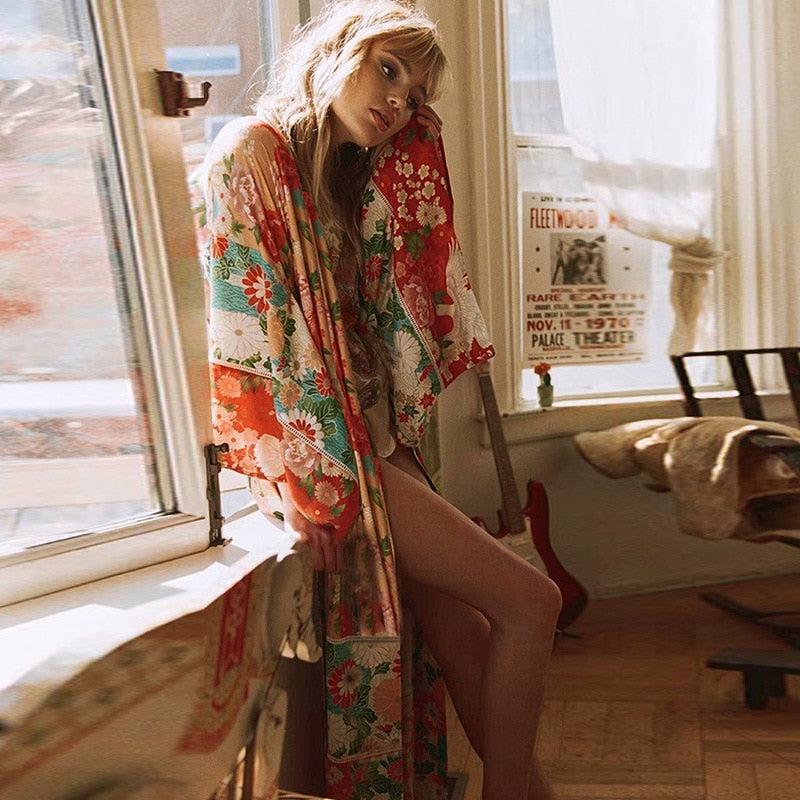
What are the different types of kimono?
A symbol of elegance and tradition, the kimono embodies the soul of Japan through its varied cuts, materials, and uses. Blending tradition and modernity, this iconic garment continues to fascinate with its aesthetic richness and social significance. Discover the different types of kimono in this review.
Kimono: What is it?
An iconic Japanese garment, the kimono is distinguished by its T-shaped cut, simple lines, and rich symbolism. Once used as a generic term for any attire, it now refers to a traditional robe worn during ceremonies or special events. Contrary to popular belief, it should not be confused with martial arts uniforms such as the judogi. The kimono embodies a strong cultural heritage, where every detail reflects:
-
identity;
-
social rank; or even
-
the season.
The different types of kimono
The kimono is more than just a traditional garment. There are a multitude of variations, each suited to a specific occasion. Depending on the wearer's status, age, or the type of event, certain styles will be favored. Here are the main categories of kimono and their significance in Japanese culture.
The mofuku
The mofuku is a kimono reserved for times of mourning. Entirely black, without any decorative pattern, it symbolizes sobriety and respect during funerals or funerary rites. It is worn by the deceased's relatives, both women and men, and consists of a well-codified ensemble:
-
a plain black kimono,
-
an obi belt also black,
-
dark accessories (shoes, bag, hairpins).
For women, the mofuku also includes specific black underwear and a discreet hairstyle. This attire, although rarely seen in everyday life, remains very important in Japanese traditions related to respect for ancestors and the cult of the dead. It reflects the seriousness of funeral rites in Japan and the essential importance given to dress codes.
The furisode
Recognizable by its long, flowing sleeves, the furisode is undoubtedly one of the most spectacular kimonos. It is traditionally worn by young, unmarried women during major ceremonies, notably the Coming of Age Festival (Seijin Shiki), celebrated at the age of 20. Often made from colorful fabrics and adorned with elegant patterns, it reflects the:
-
youth ;
-
vitality; and
-
availability to marry.
The furisode comes in several versions, depending on the sleeve length, and is tied with a wide obi belt with intricate knots. It is rarely worn daily, as it requires great skill to properly fit. This kimono remains highly sought after today for graduation photoshoots or important family events, thus perpetuating an ancestral tradition.
The homongi
Supple and versatile, the homongi is often considered the "go-to" kimono for special occasions. Its name literally means "visiting garment," and it is worn by both married and single women for receptions, ceremonies, and cultural outings. The homongi's patterns, often floral or inspired by nature, elegantly flow between the seams, creating a remarkable visual continuity. Unlike more formal kimonos, it can be made in a variety of fabrics and colors, sometimes adorned with discreet details. This kimono, both elegant and functional, perfectly illustrates how Japanese refinement adapts to the demands of everyday life while maintaining a certain solemnity. Today, it remains one of the most accessible kimonos for women wishing to mark an event with distinction.
The Tomeode
The tomesode is reserved for married women and is one of the most formal outfits in traditional Japanese women's clothing. It is primarily black, but can also be worn in other dark colors. It is also distinguished by patterns that are only present on the lower part of the garment. These ornaments often symbolize natural or mythological scenes and vary according to the season or social status. The tomesode is accompanied by several distinctive signs such as:
-
the family coat of arms (my),
-
a formally patterned obi,
-
matching and elegant accessories.
This kimono is primarily worn at weddings and formal ceremonies, particularly by the mother of the bride or groom. It embodies respect for tradition and maturity, while remaining a symbol of distinction and understated refinement.
The yukata
Lightweight, colorful, and easy to put on, the yukata is the ultimate summer kimono. Once used as a bathrobe in traditional inns (ryokan), it is now worn during summer festivals (matsuri) and fireworks displays. Made of cotton or linen, it has no lining or inner layer. This makes it perfectly suited to the heat. The yukata is as appealing for its simplicity as for the variety of its patterns, often floral or geometric.
Easily paired with geta sandals and a simple obi belt, it's beloved by all generations. Today, some are modernizing it with bold accessories, reflecting the ongoing evolution of this iconic piece.
The wedding kimono
The wedding kimono, or shiromuku, is an all-white outfit worn by the bride during a traditional Japanese wedding. White, in this context, symbolizes purity and the woman's desire to blend into the new family she is joining. Historically, this color also echoed the samurai era, when it signified the abandonment of one's past life. The shiromuku is richly embroidered with motifs of cranes, flowers, or pine trees, bearing good omens. This kimono comes with a complete set:
-
traditional headdress;
-
fan; and
-
refined accessories.
Although many Japanese brides today opt for Western dresses, the shiromuku continues to mark the most traditional weddings, particularly at Shinto shrines. It is a true textile masterpiece, imbued with powerful symbols and a meticulous aesthetic, highlighting the bride's understated and majestic elegance.
The kimono for men
Less ornate, but just as codified, the men's kimono reflects elegant sobriety. Once worn daily, it is now worn for special occasions, such as weddings, ceremonies, or cultural events. Colors are generally understated, gray, navy blue, and black, with discreet patterns. There are several types of men's kimonos, including the kinagashi and the montsuki haori hakama.
This formal attire is often worn at weddings or graduations. Less imposing than women's kimonos, men's kimonos emphasize simplicity and precision. Even today, some young Japanese are bringing these garments up to date, adapting them with modern fabrics or contemporary accessories.
What shoes to wear with a kimono?
The choice of footwear to pair with a kimono is not random, but follows specific traditional codes. Often, two types of sandals are worn. These are zōri made of rice straw, leather or fabric, and geta , wooden sandals raised by two prongs. Zōri go perfectly with kimonos dressed at weddings or official ceremonies, as they offer a more refined look. On the other hand, geta, with their characteristic sound when walking, are used more during summer festivals. In both cases, the shoes are worn with tabi , traditional white socks separating the big toe from the others. Today, some adapt these practices and pair the kimono with modern shoes, but traditional sandals remain the most faithful to the classic Japanese style.










